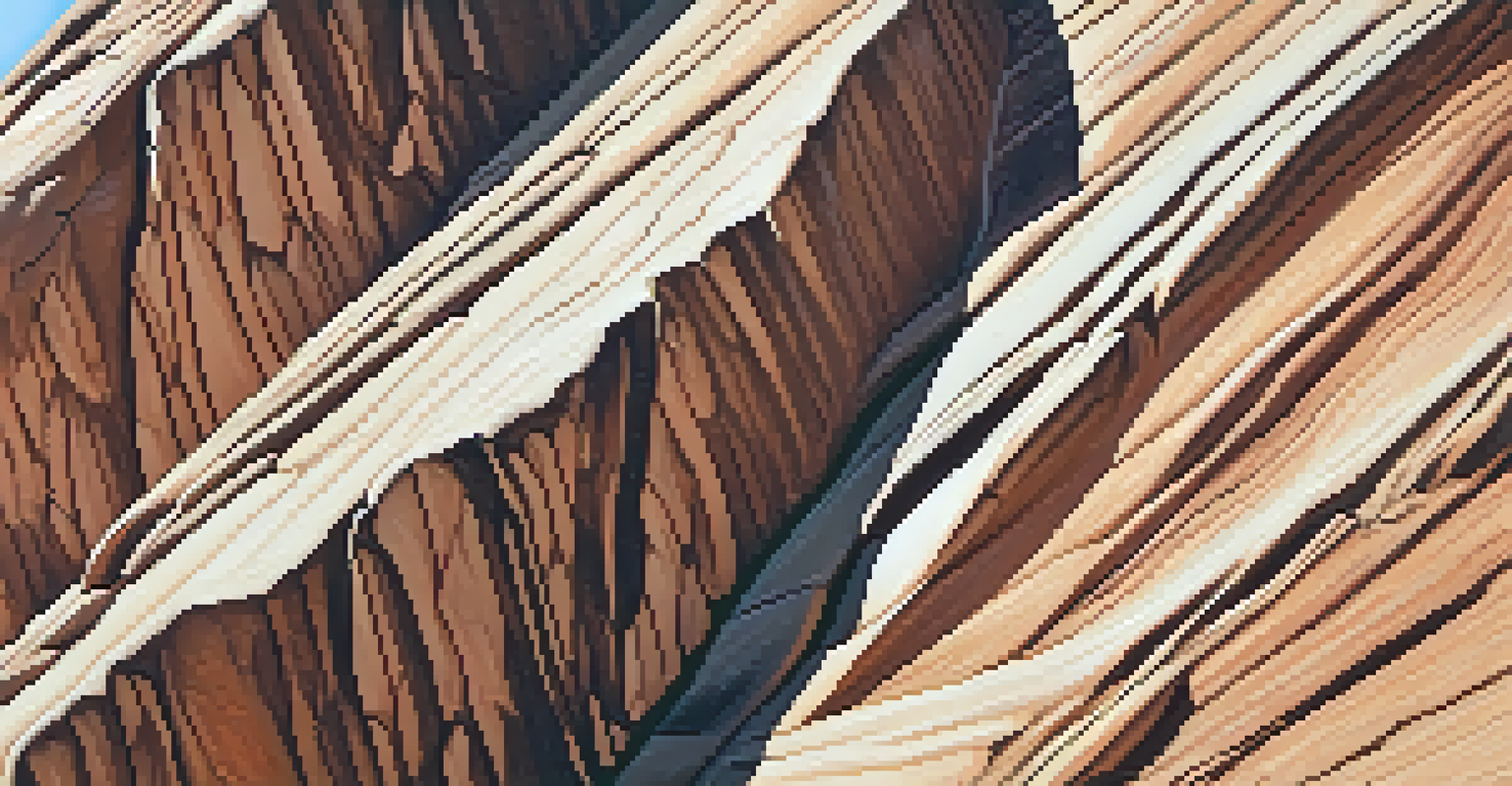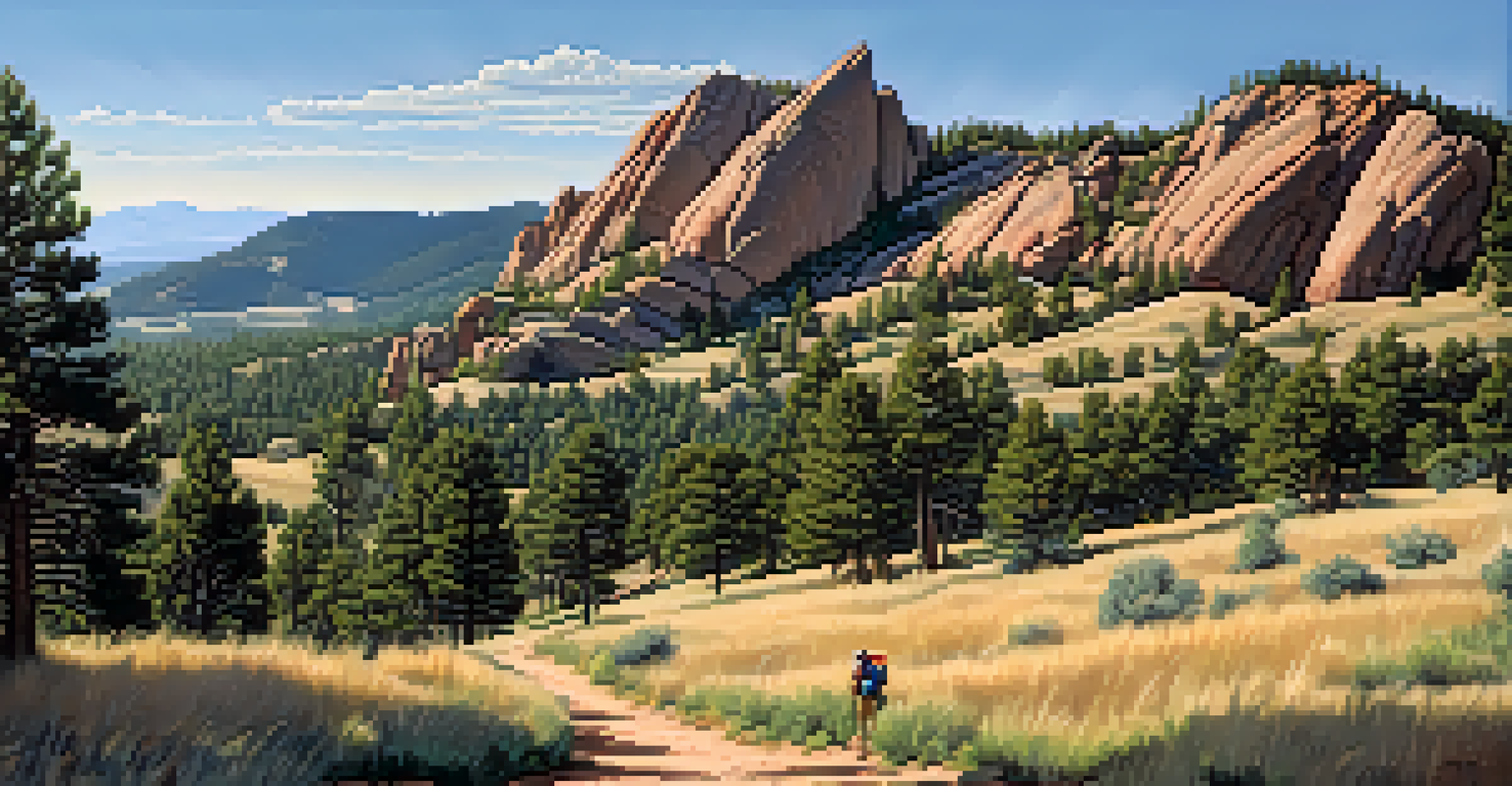Boulder's Flatirons: Iconic Geological Formations Explained

What Are the Flatirons? Understanding Their Unique Shape
The Flatirons are a series of iconic rock formations located just outside Boulder, Colorado. Their distinctive, slanted shape resembles the flat irons used for pressing clothes, hence the name 'Flatirons.' These geological marvels are not just beautiful; they are a testament to the earth's complex geological processes over millions of years.
Nature does not hurry, yet everything is accomplished.
Comprising primarily sandstone, the Flatirons are part of the Fountain Formation, which dates back to the late Pennsylvanian to early Permian periods, about 300 million years ago. This means that when you hike around these formations, you're literally walking through ancient history. The layers of rock tell a story of sedimentation, tectonic shifts, and erosion that have shaped the landscape we see today.
Visitors are often taken aback by the sheer size and unique structures of the Flatirons. The most famous, Flatiron 1, stands at an impressive 8,461 feet, while the others range in height, creating a stunning skyline against the backdrop of the Rockies. This natural beauty is not only a sight to behold but also a popular spot for outdoor activities like hiking, climbing, and photography.
The Geological History Behind the Flatirons
To truly appreciate the Flatirons, it helps to understand their geological origins. The formations were created from sediment that accumulated in ancient riverbeds and deltas, which later solidified into sandstone. Over millions of years, tectonic forces pushed these layers upward, exposing them to the elements and shaping them into their current form.

Erosion played a significant role in sculpting the Flatirons. Wind, water, and ice have all contributed to wearing away softer materials, leaving behind the more resilient sandstone. This process continues today, ensuring that the Flatirons remain dynamic and ever-changing, a reminder of nature's powerful forces at work.
Unique Geological Formations
The Flatirons are iconic rock formations in Boulder, Colorado, shaped by ancient geological processes over millions of years.
Additionally, the Flatirons are an excellent example of a geological phenomenon called 'tilting.' The layers of rock are angled, or tilted, due to the tectonic activity that lifted them. This unique orientation not only adds to their distinct appearance but also provides insights into the geological history of the area.
Flora and Fauna: Life Around the Flatirons
The ecosystems surrounding the Flatirons are as diverse as they are beautiful. The area is home to various plant species, including ponderosa pine, juniper, and wildflowers that paint the landscape with vibrant colors during the warmer months. The unique microclimates created by the formations also support a variety of ecosystems that thrive in different conditions.
In every walk with nature one receives far more than he seeks.
Wildlife enthusiasts will be delighted to know that the Flatirons are teeming with animal life. From soaring eagles and hawks that nest in the cliffs to deer and foxes that roam the foothills, the area offers ample opportunities for wildlife viewing. Birdwatchers, in particular, find the Flatirons to be a prime location for spotting various species throughout the year.
Moreover, the Flatirons serve as a crucial habitat for many native species, making conservation efforts in the area essential. Local organizations work tirelessly to protect these ecosystems, ensuring that future generations can enjoy the natural beauty and biodiversity that the Flatirons provide.
Recreational Activities: Enjoying the Flatirons Up Close
The Flatirons are a playground for outdoor enthusiasts, offering a plethora of activities for visitors of all ages. Hiking trails wind through the area, ranging from easy walks to challenging climbs, allowing everyone to experience the stunning views from various vantage points. The Chautauqua Park area is particularly popular, providing access to several well-maintained trails that lead directly to the formations.
For those seeking a bit more adventure, rock climbing is a favored activity on the Flatirons. The unique sandstone offers a variety of climbing routes, from beginner-friendly to expert-level challenges. Local climbing schools provide lessons and guided climbs, making it accessible for both novices and experienced climbers looking to test their skills.
Biodiverse Ecosystems
Surrounding the Flatirons are diverse ecosystems that support various plant and animal species, highlighting the area's rich biodiversity.
Additionally, the Flatirons are a fantastic spot for photography, with breathtaking sunrises and sunsets that create dramatic backdrops. Whether you're capturing the golden hues of dusk or the vibrant colors of wildflowers in spring, the Flatirons provide endless inspiration for photographers and nature lovers alike.
Cultural Significance: The Flatirons in Local History
The Flatirons hold a significant place in the cultural history of Boulder and its surrounding communities. For centuries, Indigenous peoples, including the Ute and Arapaho tribes, have revered these formations, viewing them as sacred landmarks. Their presence in the landscape is woven into the cultural narratives and traditions that have been passed down through generations.
In the late 19th century, as Boulder began to develop, the Flatirons became symbols of the area’s natural beauty and charm. Local leaders recognized their potential as a tourist destination, advocating for the preservation of these remarkable formations. This foresight helped ensure that the Flatirons remain a beloved landmark today, attracting visitors from around the globe.
Moreover, the Flatirons have inspired countless artists, writers, and musicians over the years. Their striking beauty and majestic presence have been captured in various forms of art, contributing to Boulder’s vibrant cultural scene. This creative legacy continues as new generations draw inspiration from the ever-changing landscape.
Conservation Efforts: Protecting the Flatirons for Future Generations
As the popularity of the Flatirons grows, so does the need for conservation efforts to protect these natural wonders. Local organizations and government agencies work together to ensure that the delicate ecosystems around the Flatirons are preserved while allowing for recreational activities. Sustainable practices are encouraged to minimize human impact on the area.
Education plays a vital role in these conservation efforts. Visitors are informed about the importance of respecting the environment, staying on designated trails, and practicing Leave No Trace principles. This awareness helps foster a sense of responsibility, ensuring that everyone can enjoy the Flatirons while protecting their natural beauty.
Outdoor Recreation Hub
The Flatirons offer a playground for outdoor enthusiasts with activities like hiking, rock climbing, and photography, attracting visitors year-round.
The ongoing conservation initiatives aim to balance accessibility with preservation, ensuring that future generations can experience the awe and wonder of the Flatirons. By supporting local efforts, visitors can contribute to the protection of this iconic landscape and its rich biodiversity.
Planning Your Visit: Tips for Exploring the Flatirons
If you're planning a trip to the Flatirons, a little preparation can go a long way in making your experience enjoyable. Start by checking the weather forecast, as conditions can change rapidly in the mountains. Dressing in layers is advisable to ensure you stay comfortable, whether it's sunny or chilly. Don’t forget sturdy hiking shoes, as the trails can be rocky and uneven.
Arriving early in the day can help you avoid crowds and secure parking, especially during peak tourist seasons. The Chautauqua Park area is a popular starting point, offering easy access to several trails leading to the Flatirons. Be sure to carry plenty of water and snacks, as you’ll want to stay hydrated and energized during your adventures.

Lastly, take the time to soak in the views and enjoy the moment. Whether you're hiking, climbing, or simply admiring the scenery, the Flatirons are a stunning reminder of nature's beauty. Capture some photos, but also remember to put your camera down occasionally and take it all in—the experience is just as important as the pictures.